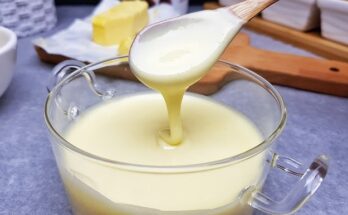Cream Cheese Recipe: Let’s be honest—store-bought cream cheese is convenient, but making your own at home is a game-changer. Why? For starters, homemade cream cheese tastes fresher, richer, and you have complete control over what goes in it. No preservatives, no additives—just pure, creamy goodness. If you’ve never tried making it from scratch, you’re in for a treat. The process is simple, cost-effective, and surprisingly fun. Plus, you’ll wow your family and friends when you tell them it’s homemade!
Homemade cream cheese also gives you flexibility in terms of flavor. Want it tangier? Add more lemon. Prefer it mild and creamy? Adjust your milk-to-cream ratio. You’re the boss here. It’s also a great way to use up milk that’s close to its expiration date. So, whether you’re spreading it on a bagel, using it in cheesecake, or whipping it into a savory dip, homemade cream cheese will elevate your dishes like never before.
Benefits of Homemade Cream Cheese
Besides the unbeatable taste, there are some serious perks to making cream cheese at home. First up—quality. You get to choose your ingredients. Whether it’s organic whole milk, fresh lemon juice, or high-quality salt, you’re in control. Next is the cost. Homemade cream cheese is incredibly affordable, especially when compared to premium brands in stores.
Another big benefit? Customization. Want a garlic and herb spread? Easy. A touch of honey and cinnamon for breakfast? Done. The possibilities are endless. Plus, making your own dairy products can be surprisingly therapeutic. It brings a sense of accomplishment, like baking your own bread or growing your own veggies. And if you’re trying to cut down on processed foods, this is a great step in the right direction.
Ingredients Needed for Cream Cheese
Basic Ingredients You’ll Need
Making cream cheese requires just a handful of ingredients. Here’s what you’ll need:
- Milk: Whole milk works best for creaminess. Avoid ultra-pasteurized milk as it doesn’t curdle well.
- Heavy Cream (Optional): For an extra creamy texture.
- Acid: Lemon juice or white vinegar works well to separate the curds from the whey.
- Salt: A pinch for taste.
That’s it! Simple, right? These basic ingredients are likely already in your kitchen, making it easy to whip up a batch without a trip to the store. The key is to use high-quality, fresh milk—preferably non-homogenized if you can find it. The cream is optional but recommended if you want that smooth, spreadable texture. And as for the acid, fresh lemon juice not only works well but also adds a subtle citrusy note.
Optional Ingredients for Flavor Variations
Once you’ve mastered the basic cream cheese, you can start experimenting with flavors. Here are a few optional add-ins to get creative:
- Garlic and Herbs: Try minced garlic, chopped chives, dill, or parsley.
- Spices: Cracked black pepper, smoked paprika, or chili flakes.
- Sweet Additions: Honey, cinnamon, or fruit preserves for a dessert-style spread.
- Savory Boosts: Sun-dried tomatoes, olives, or caramelized onions.
These ingredients can be blended in after your cream cheese is made. Start with small amounts and taste as you go. Remember, it’s easier to add more than to take away!
Tools and Equipment Required
Essential Kitchen Tools
To make cream cheese at home, you don’t need a professional kitchen. Here’s a basic list of tools you’ll need:
- Heavy-Bottomed Pot: For heating the milk evenly.
- Thermometer: To monitor the milk’s temperature (optional but helpful).
- Fine Mesh Strainer or Cheesecloth: For draining the whey from the curds.
- Mixing Bowl: To catch the strained whey.
- Blender or Food Processor: For achieving that creamy, spreadable texture.
All these tools are likely already in your kitchen, and they’re all reusable for other recipes. If you plan to make cream cheese regularly, it might be worth investing in a high-quality cheesecloth that you can wash and reuse.
Optional Tools for Better Texture and Storage
- Colander: For easier draining, especially if you’re using a double layer of cheesecloth.
- Storage Containers: Airtight containers to keep your cream cheese fresh in the fridge.
- Spatula: For scraping down the sides when blending.
These extras just make the process a bit smoother and more efficient. Having the right tools can turn a messy job into a fun and satisfying experience.
Step-by-Step Process to Make Cream Cheese
Step 1: Gather Your Ingredients and Tools
Preparation is key. Make sure all your ingredients are measured out and your tools are clean and ready. You don’t want to be scrambling for your cheesecloth while your milk is curdling!
This step includes:
- Pouring out your milk and optional cream into the pot.
- Measuring your acid—typically about 3 tablespoons per liter of milk.
- Setting out your cheesecloth or strainer over a bowl.
Getting everything prepped ahead of time makes the process go much more smoothly.
Step 2: Heat the Milk
Heat your milk slowly in a heavy-bottomed pot over medium heat. Stir occasionally to prevent scorching. You’re aiming for a temperature of around 185°F (85°C). If you don’t have a thermometer, look for gentle bubbling around the edges.
Once it’s hot enough, remove it from the heat. The next step has to happen fairly quickly, so don’t walk away!
Step 3: Add the Acid
This is the magic moment where milk transforms into curds and whey. Gently stir in your acid—lemon juice or vinegar—slowly while the milk is still hot. Stir in a circular motion for about 30 seconds, then stop and let the mixture sit undisturbed for 10-15 minutes.
You’ll start to see the milk separating. The curds (solid white chunks) will separate from the whey (a yellowish, watery liquid). Don’t panic if this doesn’t happen immediately—sometimes it takes a few minutes for full separation. If you’re not seeing much action, you can add a bit more acid, a teaspoon at a time, and gently stir again.
Watching milk curdle might seem odd at first, but this natural reaction is at the heart of all cheese-making. Once it’s fully separated, you’re ready for the next step.
Step 4: Strain the Curd
Now it’s time to separate the curds from the whey. Line a fine mesh strainer or colander with a double layer of cheesecloth and place it over a large bowl. Carefully pour the curdled mixture into the cheesecloth.
Let it drain for about 30 minutes. For firmer cream cheese, you can leave it longer or gently squeeze the cloth to release more whey. If you like a softer, more spreadable texture, 30 minutes should do the trick.
After straining, you’ll be left with a bundle of creamy curds in the cheesecloth. The whey collected in the bowl can be saved for other uses—it’s full of protein and can be added to smoothies, soups, or even used to bake bread.
At this point, you’ve basically got a rustic farmer’s cheese. To turn it into smooth, silky cream cheese, we need one final step.
Step 5: Blend Until Smooth
Transfer the curds to a food processor or blender. Add a pinch of salt (about ¼ teaspoon for every 2 cups of curds) and blend until smooth. This will take a few minutes, and you may need to scrape down the sides occasionally.
If your cream cheese feels too thick, add a tablespoon or two of whey or milk to thin it out. Keep blending until the mixture is completely smooth and creamy. Taste and adjust salt or other flavorings as needed.
Once you’re happy with the consistency and flavor, transfer your cream cheese to an airtight container and refrigerate. It will thicken slightly as it chills and will keep for up to 1 week in the fridge.
Tips and Tricks for Perfect Cream Cheese
Common Mistakes to Avoid
Even though making cream cheese is simple, a few common mistakes can trip you up:
- Using Ultra-Pasteurized Milk: It doesn’t curdle well. Always check the label and opt for fresh, whole milk.
- Not Heating the Milk Enough: The milk needs to be hot (not boiling) to curdle properly.
- Over-Stirring After Adding Acid: This can break up the curds too much. Stir gently and then let it sit.
- Straining Too Long or Too Hard: If you squeeze the curds too much, the cheese can become dry and crumbly.
- Skipping the Blend: Without blending, your cheese may be grainy. For that classic cream cheese texture, the blender is key.
How to Adjust Texture and Flavor
Want thicker cream cheese? Let it drain longer or blend it with less whey. Prefer it lighter? Add a splash of milk or cream during blending.
For a tangier flavor, use more lemon juice. Want it milder? Use white vinegar instead. You can even mix in sour cream for an ultra-rich variation.
Here are some ideas to tweak your cream cheese:
- Creamier Texture: Add heavy cream or even a bit of butter while blending.
- Lighter Flavor: Reduce the salt or mix in a spoonful of Greek yogurt.
- Unique Variations: Add herbs, spices, sweeteners, or other mix-ins for personalized flavors.
Experiment a little. The beauty of homemade is that you can make it exactly the way you like it.
Storing and Using Homemade Cream Cheese
How to Store Cream Cheese Safely
Once your cream cheese is made and blended to perfection, proper storage is key to preserving its flavor and freshness. Store it in an airtight container, ideally glass or BPA-free plastic, to avoid absorbing any unwanted fridge odors. Label it with the date you made it—homemade cream cheese typically stays good for up to 7 days in the refrigerator.
Avoid storing it at room temperature, as it’s a dairy product and can spoil quickly. If you make a large batch, consider splitting it into smaller portions so you’re only opening what you need. Always use clean utensils when scooping out cream cheese to prevent contamination.
Freezing cream cheese is an option, although the texture may change slightly once thawed—it can become more crumbly. If you do freeze it, consider using it in cooked dishes like casseroles or baked goods, where the texture won’t be as noticeable.
Creative Ways to Use Homemade Cream Cheese
So, you’ve got this luxurious, creamy spread—now what? The options are practically endless. Here are a few creative ideas:
- Spread it on Bagels: A classic for a reason. Try it plain or flavored.
- Use it in Baking: Think cheesecakes, cream cheese frosting, or stuffed pastries.
- Mix into Dips: Combine with herbs, spices, or roasted vegetables for an epic dip.
- Add to Mashed Potatoes: A spoonful adds creaminess and tang.
- Make Pasta Sauces: Stir it into hot pasta for a creamy, cheesy finish.
- Stuff Chicken or Vegetables: Mix with garlic and herbs for a delicious stuffing.
Homemade cream cheese adds a rich, velvety touch to so many dishes. And since you control the ingredients, it’s a healthier, tastier option for everyday cooking.
Health Benefits of Homemade Cream Cheese
Nutritional Profile of Homemade Cream Cheese
Homemade cream cheese can be a wholesome addition to your diet—especially when made with whole, natural ingredients. It’s a good source of:
- Protein: Supports muscle growth and repair.
- Calcium: Essential for strong bones and teeth.
- Vitamin A: Important for immune health and vision.
- Healthy Fats: Helps you feel full and satisfied.
Compared to processed versions, your homemade cream cheese has no artificial additives, preservatives, or excess sodium. You can also adjust the fat content by using different milk types—skim for lower fat or whole milk for a richer version.
As with any dairy product, moderation is key. But when you make it yourself, you know exactly what you’re getting—and that’s a big win.
FAQs about Cream Cheese Recipe
1. Can I make cream cheese without a starter culture or rennet?
Yes, you can! Homemade cream cheese can be made using simple ingredients like milk, lemon juice or vinegar, and salt. These natural acids help curdle the milk and give it that creamy, tangy texture without the need for specialty ingredients.
2. How long does homemade cream cheese last?
Homemade cream cheese can be stored in an airtight container in the refrigerator for up to 7–10 days. Always check for changes in smell or texture before use.
3. What kind of milk should I use for the best cream cheese?
Whole milk is the best option for a rich and creamy texture. Avoid ultra-pasteurized milk, as it doesn’t curdle well. You can also use cream to make it extra luscious.
4. Is it cheaper to make cream cheese at home?
Yes, making cream cheese at home is generally more cost-effective, especially if you already have the basic ingredients. Plus, you avoid additives and preservatives found in store-bought options.
5. Can I flavor homemade cream cheese?
Absolutely! You can mix in herbs, garlic, chives, honey, or even fruit for a sweet version. Just add your flavors during the blending process for the best result.
6. Why is my cream cheese grainy instead of smooth?
Grainy texture usually results from overcooking or using milk that’s too hot. Keep your heat low and strain the curds gently for a silky-smooth finish.
7. Can I use plant-based milk to make vegan cream cheese?
Yes! Cashews, almonds, or soy milk can be used to make vegan cream cheese. The process is slightly different but still easy and delicious.
8. What’s the difference between cream cheese and regular cheese?
Cream cheese is a fresh cheese with a high moisture content and mild flavor. It’s not aged like cheddar or gouda and is made to be soft and spreadable.
9. Can I freeze homemade cream cheese?
Technically yes, but freezing can alter the texture, making it crumbly. It’s best used fresh, but if needed, freeze in a sealed container and thaw in the fridge before use.
10. Is homemade cream cheese healthier than store-bought?
In many cases, yes. Homemade versions contain fewer additives and preservatives, and you control the amount of salt or fat based on your preference.
Conclusion
Homemade cream cheese might sound like something only culinary pros tackle, but it’s actually incredibly simple and rewarding. With just a few ingredients and basic tools, you can create a creamy, versatile spread that’s healthier and tastier than anything off the shelf. Whether you enjoy it on a bagel, in a dip, or as the base of a rich cheesecake, homemade cream cheese delivers a freshness and depth of flavor you won’t find in store-bought versions.
Plus, once you master the basic method, you open the door to endless customization—think garlic and chive, sweet cinnamon, or spicy jalapeño. Making your own cream cheese is not only cost-effective, it’s a fun kitchen project that brings homemade joy to your meals.
So next time you run out of cream cheese, don’t rush to the store—head to your kitchen instead. You’ll be surprised just how easy and satisfying it is to make your own.



